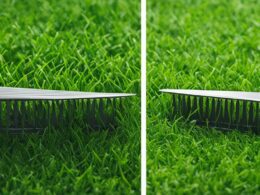If you’re limited on garden space but have a concrete patio or other hard surface, don’t worry – you can still enjoy the benefits of a raised garden bed. Building a raised garden bed on concrete requires proper drainage, adequate bed depth, and high-quality soil. By following these steps, you can successfully create a thriving garden on a hard, impervious surface.
If you’re ready to start your own raised garden bed on concrete, here are the key takeaways:
Post Summary:- Choosing a sunny and level location is important for your raised bed on concrete
- Ensure the depth of your bed is sufficient for healthy root growth and moisture retention
- Use high-quality soil and compost to provide essential nutrients for your plants
- Create a “basket” within the bed to contain the soil and prevent soil runoff
- Building a raised bed with a solid bottom is an alternative option for containing the soil
Choosing the Right Location for Your Raised Bed
When placing a raised garden bed on concrete, it’s crucial to choose an optimal location that provides the necessary conditions for your plants to thrive. Here are some key considerations to keep in mind:
Sunny Location
Ensure that your raised bed is placed in a sunny spot where your plants can receive at least six hours of direct sunlight each day. Most vegetables and flowers require ample sunlight for healthy growth and productivity. Assess the area throughout the day to determine the sunniest location for your raised bed.
Proper Drainage
When building a raised garden bed on concrete, it’s important to establish proper drainage to prevent waterlogging and ensure the health of your plants. Instead of placing the soil directly onto the concrete, create a wire and fabric “basket” within the bed. This will allow excess water to drain out while retaining sufficient moisture for the plants.
Level Surface
A level surface is essential for the stability and functionality of your raised bed. Before placing the bed, make sure the concrete can handle the weight of the garden bed and the moisture it will retain. Use a spirit level to ensure that the surface is completely level, as tilting can cause water accumulation at one end of the bed and uneven distribution of nutrients to your plants.
Consider these factors carefully when selecting the location for your raised garden bed on concrete. By providing ample sunlight, promoting proper drainage, and ensuring a level surface, you can create an ideal environment for your plants to flourish.
Determining the Depth of Your Raised Bed
When building a raised garden bed on concrete, it’s important to determine the appropriate depth to ensure healthy plant growth. Most common vegetable plants require a minimum depth of 12 inches, with deeper beds of at least 18 inches being recommended. This allows for ample root space, soil volume, and nutrient absorption.
Having enough depth in your raised bed is especially crucial when placing it on concrete, as it helps retain moisture and reduces water runoff. To achieve the desired depth, consider using 2×6″ boards to construct a bed that is 22 to 24 inches deep. This provides enough soil capacity for plant roots to thrive and ensures that water is effectively retained within the bed.
With sufficient depth, your plants will have the space they need to establish strong root systems and access essential nutrients for healthy growth. Investing in the proper depth for your raised bed is a critical step in creating an optimal environment for successful gardening on concrete surfaces.
Benefits of Ample Depth in a Raised Bed
The benefits of providing ample depth in your raised bed extend beyond just root space. A deeper bed allows for increased soil volume, which means more room for nutrient-rich soil amendments and organic matter. This promotes better soil fertility and overall plant health.
Furthermore, deeper beds help insulate plant roots from extreme temperature fluctuations, providing a more stable and favorable environment for growth. The additional soil depth also allows for improved moisture retention, reducing the frequency of watering and preventing soil dryness.
Considerations for Building a Deep Raised Bed on Concrete
When constructing a deep raised bed on concrete, it’s important to ensure the structure is sturdy and can support the weight of the soil. Use strong, durable materials and consider reinforcing the corners and edges of the bed to withstand the pressure exerted by the soil. Additionally, be mindful of any potential drainage issues and create adequate outlets to prevent water buildup within the bed.
By taking the time to determine the appropriate depth for your raised bed and implementing proper construction techniques, you can create an ideal growing space for your plants. Enjoy the benefits of a thriving garden, even on concrete surfaces.

Choosing the Right Soil for Your Raised Bed
When it comes to creating a successful raised garden bed on concrete, choosing the right soil is essential. High-quality soil is key to ensuring proper drainage and soil retention, as the concrete surface can pose challenges in terms of moisture control. By using a combination of bagged soils, compost, and homemade compost, you can provide your plants with the nutrients they need for thriving.
One important aspect to consider is the composition of the soil mix. While potting soil may seem like a convenient option, it tends to drain too quickly, potentially leaving your plants susceptible to drought. To promote moisture retention, incorporate compost and worm castings into the soil mix. These organic materials help to hold onto water, reducing the frequency of watering and providing a steady supply of moisture for your plants.
Additionally, mulching the surface of the soil can further aid in retaining moisture. A layer of mulch helps to prevent evaporation, keeping the soil consistently moist. This is particularly important for raised garden beds on concrete, as the impervious surface can cause water to run off quickly.
Benefits of Using High-Quality Soil:
- Improved drainage: High-quality soil allows excess water to flow through the raised bed, preventing waterlogged roots.
- Optimal nutrient absorption: The rich organic matter in high-quality soil provides essential nutrients for plant growth.
- Moisture retention: The inclusion of compost and worm castings helps the soil hold onto moisture, reducing the need for frequent watering.
- Reduced weed growth: High-quality soil can help suppress weed growth, ensuring your plants have access to resources without competition.
Remember, the soil in your raised bed is the foundation for successful gardening. By choosing high-quality soil and incorporating organic matter, you can create an optimal environment for your plants to thrive.
| Soil Components | Benefits |
|---|---|
| Bagged soils | Provides a consistent base for the soil mix |
| Compost | Enriches the soil with organic matter and nutrients |
| Homemade compost | Utilizes kitchen scraps and yard waste for sustainable gardening |
| Worm castings | Improves soil structure and adds beneficial microorganisms |
By combining these soil components in the right proportions, you can create a high-quality soil mix that will support the health and growth of your plants in a raised garden bed on concrete. Remember to prioritize soil quality when planning and preparing your raised bed, as it is crucial for the long-term success of your garden.

Containing the Soil in Your Raised Bed
When placing a raised garden bed on concrete, it’s important to take measures to prevent soil runoff and ensure proper containment. Adding soil directly onto the concrete surface can lead to mess, erosion, and potential alkalinity issues. Instead, create a sturdy “basket” within the wood frame of the bed to contain the soil. This will help maintain the integrity of the bed and provide a stable environment for your plants.
To create the soil containment, line the bottom and sides of the raised bed frame with wire mesh or landscape fabric. This will act as a barrier, preventing the soil from seeping out of the bed and onto the concrete. Make sure the wire mesh or fabric is securely fastened to the bed frame to ensure it stays in place.
Additionally, when building a raised bed on concrete, it’s important to consider the alkalinity of the concrete. Concrete can have a high pH level, which can affect the pH of the soil and hinder plant growth. To mitigate this, you can use a layer of plastic or a waterproof membrane as a barrier between the concrete and the soil. This will help prevent direct contact and minimize the impact of alkalinity on your plants.
Alternative Approach: Solid Bottom Raised Bed
If constructing a raised bed with a soil containment “basket” is not feasible, another option is to build a raised bed with a solid bottom. This approach requires a different construction method but offers its own benefits. A solid bottom raised bed eliminates the need for a containment barrier and can be particularly useful when dealing with concrete or other hard surfaces.
When building a solid bottom raised bed, ensure proper drainage by incorporating drainage holes in the bottom of the bed. These holes will allow excess water to escape, preventing oversaturation of the soil. Additionally, consider using a well-draining soil mix to further promote healthy plant growth.
By taking these measures to contain the soil in your raised bed, you can prevent soil runoff, maintain a tidy gardening space, and create an optimal environment for your plants to thrive.
Can I Use Concrete Pavers to Create a Raised Garden Bed?
When it comes to creating a raised garden bed, utilizing concrete pavers can be a viable option. Placing concrete pavers on grass provides a strong base for your garden bed, ensuring stability and durability. Whether you’re growing flowers, vegetables, or herbs, this method allows you to easily customize the size and shape of your garden bed while adding a stylish touch to your outdoor space.
Conclusion
Creating a raised garden bed on concrete or other hard surfaces can open up new possibilities for gardening in limited spaces. By following a few key steps, you can enjoy the benefits of homegrown vegetables, herbs, and flowers right on your patio or hard surface area.
First and foremost, choose the right location for your raised bed. Ensure it receives ample sunlight and is on a level surface. Consider the weight and moisture retention of the concrete to ensure its stability.
Next, determine the depth of your raised bed. Providing enough root space and soil depth is crucial for healthy plant growth. Aim for a minimum depth of 18 inches, and consider using 2×6″ boards to create a 22 to 24-inch deep bed.
When it comes to selecting soil, opt for a high-quality mix that includes compost and organic matter. This will provide essential nutrients and help retain moisture. Avoid using only potting soil, as it may drain too quickly. Mulching the soil surface can further aid in minimizing water evaporation.
Lastly, contain the soil within the raised bed by creating a sturdy “basket” within the wood frame. This prevents soil runoff, reduces mess and erosion, and mitigates potential alkalinity issues caused by direct contact between soil and concrete.
With these tips in mind, you can successfully create a thriving garden on a hard, impervious surface. Enjoy the satisfaction of growing your own produce and beautifying your outdoor space, regardless of limited garden space.
FAQ
Can I build a raised garden bed on concrete?
Yes, you can still enjoy the benefits of a raised garden bed on a hard surface like concrete. By following certain steps, you can successfully create a thriving garden on concrete.
What should I consider when placing a raised garden bed on concrete?
It’s important to choose a sunny, level location for your raised bed on concrete. Make sure the concrete can handle the weight of the bed and moisture. Avoid placing the soil directly on the concrete and create a wire and fabric “basket” within the bed to promote drainage.
How deep should my raised garden bed be on concrete?
Most vegetable plants require a minimum depth of 12 inches, but it’s recommended to have at least 18 inches or deeper. This allows for ample root space, soil volume, and nutrient absorption. Consider using 2×6″ boards to build a 22 to 24-inch deep bed.
What kind of soil should I use for a raised garden bed on concrete?
Use high-quality soil and compost to compensate for the shallower root space. A good soil mix consists of a combination of bagged soils, compost, and homemade compost. Avoid using only potting soil as it drains too quickly.
How can I contain the soil in my raised garden bed on concrete?
It’s not recommended to add soil directly onto the concrete surface. Instead, create a sturdy “basket” within the wood frame of the bed to contain the soil. This prevents soil seepage, reduces mess and erosion, and avoids potential alkalinity issues caused by direct contact between soil and concrete.
Can I use a solid bottom for my raised garden bed on concrete?
Yes, building a raised bed with a solid bottom is an alternative option. However, it requires a different approach and considerations compared to a bed with a wire and fabric “basket” for drainage.









